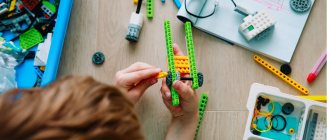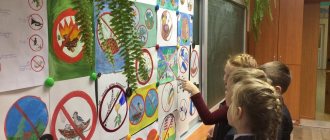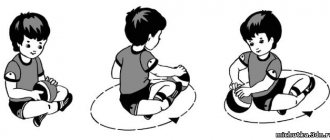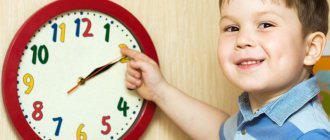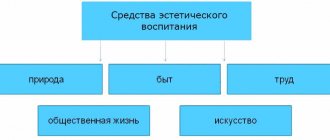The role of physical education in the development and education of a preschool child
Preschool age is the most important period for the formation of motor activity. Children strive to satisfy their biological need for movement, and in older preschool age they have a rich creative imagination. With proper guidance, this helps them master complex movement development program material.
By the time they enter school, children should have developed the basic motor skills of walking, running, jumping, throwing, climbing, and in some types of sports exercises and games.
Insufficient development of any motor quality in a child reduces his ability to learn new motor actions, as well as his motor activity. In this regard, it is necessary to provide in the planning of program material for physical education classes the relationship of the learning process with the main types of movements and the development of motor qualities and abilities of children.
When conducting physical education classes, the main attention is paid to the formation of motor skills, expanding the motor experience of children, developing physical qualities and abilities, promoting health, and increasing the functional capabilities of preschool children. Various programs of education and training in kindergarten contain requirements for performing physical exercises taking into account age, a list of physical exercises is given, but the amount of knowledge that would allow the formation of a general method of action when using a group of homogeneous movements is not defined.
Basic movements belong to applied motor actions; they are widely used by the child to solve motor problems in play and practical activities. Each such movement can be performed in various ways, only some of which will be appropriate for successfully solving a motor task in a specific situation. It is no coincidence that P. F. Lesgaft emphasized that the tasks of “physical education will consist in the ability to isolate individual movements and compare them with each other, consciously manage them and adapt to obstacles, overcoming them with the greatest possible dexterity and perseverance, in other words, to accustom them with the least possible by labor, in the shortest possible period of time, to consciously produce the greatest physical work or to act gracefully and energetically.”
It should be remembered that physical education is a form of work that provides children with the experience of expedient and health-saving movements.
Objectives of physical education classes
At each lesson, as a rule, a set of interrelated tasks is solved: health-improving, educational and educational. They are aimed at developing rational, economical, conscious movements in the child, accumulating motor experience and transferring it into everyday life.
Health-improving tasks are aimed at creating a healthy lifestyle and cultivating a conscious attitude towards the manifestation of one’s physical activity. They contribute to harmonious psychosomatic development, improvement of the body’s protective functions through hardening, increasing resistance to various diseases, adverse environmental influences, and increasing the child’s performance.
Health objectives are specified taking into account the individual developmental characteristics of the child’s body and are aimed at:
- formation of correct posture; — timely ossification of the musculoskeletal system; - formation of spinal curves; - development of the arches of the feet; — strengthening the ligamentous-articular apparatus; — development of a harmonious physique; - regulation of bone growth and mass; - development of the muscles of the face, torso, legs, arms, shoulder girdle, hands, fingers, neck, eyes, internal organs - heart, blood vessels, respiratory muscles, etc.; Particular attention is paid to the development of extensor muscles.
When developing the content of educational tasks, it is important to pay attention to the development of independence, activity and communication, as well as the formation of the emotional, moral and volitional sphere of children in the process of motor activity.
Educational tasks:
- need for daily exercise; – the ability to rationally use physical exercises in independent motor activity; - acquisition of grace, plasticity, expressiveness of movements; - independence, creativity, initiative; - self-organization, mutual assistance.
In addition, the child develops hygiene skills, the habit of self-care, helping the teacher in conducting and organizing various forms of sports games.
Thanks to physical education:
— favorable conditions are created for the formation of positive character traits (organization, modesty, responsiveness, etc.); — the moral foundations of the individual are laid (self-esteem, justice, camaraderie, mutual assistance, responsibility for the assigned work, the ability to work in a team); — volitional qualities are cultivated (courage, determination, self-confidence, endurance, perseverance in overcoming difficulties, self-control); — a culture of feelings and an aesthetic attitude to physical exercise are instilled.
Educational objectives involve the formation of motor skills and abilities, the development of psychophysical qualities (speed, strength, flexibility, endurance, eye, dexterity); development of motor abilities (balance functions, coordination of movements).
In the process of physical education, the child:
— acquires a certain system of knowledge about physical exercises, their structure, health-improving effects on the body; - is aware of his motor actions; - masters physical education and spatial terminology (starting positions, column, line, etc.; back and forth, up and down, etc., gains the necessary knowledge about performing movements, sports exercises and games; - learns the names of objects, equipment, aids, methods and rules for using them; - the child gets to know his body, he develops bodily reflection.
By doing physical exercises, the child enriches knowledge about the surrounding nature. His vocabulary improves, memory, thinking, and imagination develop.
Physical education helps a child become involved in sports. He acquires knowledge about leading world and domestic athletes, which significantly expands his horizons.
The content of the classes consists of physical exercises and games provided for in the program for each age group. When selecting program content, it is important to wisely complicate tasks, observing the principles of systematicity, consistency and accessibility.
Systematicity is manifested in the interrelation of knowledge, skills and abilities. The system of preparatory exercises allows you to move on to mastering a new movement and, relying on it, begin to learn subsequent, more complex material. Regularity, systematicity, and continuity of physical education throughout preschool age ensure the principle of systematicity.
In all age groups, a clear sequence of physical education classes must be observed with the obligatory alternation of loads and rest, as well as consistency, continuity, and interrelationship in the content of the classes .
Structure of a physical education lesson
The structure of the lesson consists of children sequentially performing a set of physical exercises and games. It is determined by the assigned tasks and the performance characteristics of the child’s . The highest level of a child’s depends on the nature of the activity.
The introductory part is aimed at activating children’s attention and gradually preparing the body to perform more complex exercises and increased physical activity, which are planned in the main part of the lesson . This includes: various types of walking, running, hopping, jumping, simple game exercises for attention and coordination of movements, building and rebuilding, exercises for posture, and strengthening the foot. A simple set of obstacle course exercises may be suggested.
The main part solves a set of program tasks: differentiated training in basic types of movements, selected taking into account the level of development of motor activity (MA) of children; development of motor skills and physical qualities; training of functional characteristics of the body. This part of the lesson begins with performing general developmental from various starting positions (standing, sitting, lying). A set of general developmental exercises includes 6-8 exercises:
1-2 – for the arms and shoulder girdle (bending the arms at the elbows, circular rotation, etc.); 1-2 – for the body (bending), etc.; 1-2 – for legs (swing the leg forward, clap under the leg) jumping, skipping, running and walking in place.
After completing the complex, exercises to restore breathing follow. After a set of general developmental , the main types of movements follow. program material on the development of movements for preschool children taking into account the degree of intensity ( high, medium, low ).
Exercises in the main types of movements of varying degrees of intensity can be combined as follows:
- high-intensity exercises are combined with low-intensity exercises; for example, a running high jump goes well with throwing a ball up and catching it with one or two hands; - high-intensity exercises are combined with moderate-intensity exercises; for example, running after the ball and dribbling it with either the right or left hand. - high-intensity exercises are also combined with high-intensity exercises; for example, crawling on a gymnastic bench with pull-ups and running long jumps.
The selection of lesson material involves the use of exercises of a predominantly dynamic nature, aimed at developing various muscle groups.
The main part of the lesson ends with a general outdoor game. Outdoor games, as a rule, are variable in nature: with the complication of the task, changing the distance for running, jumping, throwing, changing the pace of their execution, increasing the number of “traps,” and complicating the rules in the games.
The final part of the physical education lesson is aimed at ensuring a gradual decrease in DA, relieving general agitation and bringing the child’s heart rate to normal. The third part of the lesson includes: fast walking with a gradual slowdown, breathing exercises.
Types of physical education activities
To complete the physical education program, different types of classes are planned.
A traditional type of lesson can be educational, mixed or variable.
The training session is aimed at introducing new program material. A mixed activity helps to learn new movements and improve previously mastered ones. It is based mainly on repetition of the material covered. A variable activity is based on well-known material, but with the inclusion of complicated variants of motor tasks (in outdoor games, on an obstacle course, in relay races).
The training type lesson is aimed at developing the motor and functional abilities of children. It includes a large number of cyclic exercises, elements of acrobatics, and differentiated motor tasks for the development of reaction speed, agility, and endurance.
The game lesson is based on a variety of outdoor games and relay races.
Classes using exercise equipment and sports complexes include a variety of exercises: hanging, climbing a rope, pole, gymnastic wall, rope ladder, exercises on “Health” disks, with expanders, dumbbells, etc. It is important that children acquire certain motor skills and skills, learned to use exercise equipment independently, and mastered techniques.
A lesson of a complex nature (synthesis of different types of activities). As a rule, game exercises such as “Who collected the most objects”, “Collect cubes by color, in pairs, by shape” are used.
Methodological techniques necessary to enhance the motor activity of children in physical education classes:
— rational use of physical education equipment (equipment should be used as much as possible); - inclusion of different ways of organizing children (frontal, continuous, group, shift, circuit training, station, individual); — explanation of tasks and demonstration of exercises; - activation of the child’s mental activity (use of spatial terminology; - variability of outdoor games, methods of complicating them.
An important indicator of the effectiveness of physical education classes is physical activity, which can satisfy children’s need for movement.
The importance of physical education in preschool educational institutions
The importance of physical education for the development of preschool children.
Movement, physical education, a healthy lifestyle are the key to the health of our children, our new generation!
It is impossible to imagine a healthy and happy child being motionless. In our minds, a fidget running along the street is healthier than a child lying on the sofa in the middle of the day. And it is right! Without the correct and comprehensive development of a child’s muscles, his overall development and health are impossible.
From the moment of birth, a healthy baby strives for movement. Movements tone a person’s muscles, having an important impact on the child’s overall well-being. In the future, the child’s movements need to be properly controlled. A set of exercises in physical education in kindergarten is aimed at a specific age group.
Correct active movements of a child increase his resistance to various diseases, activate the body's defenses, its immunity, and increase the activity of leukocytes. Physical education contributes to the comprehensive development of children: mental abilities, thinking, attention, spatial concepts, perception, the formation of the skeleton and its strength, correct posture and improvement of the child’s immune system.
Sports activities are a form of organized systematic teaching of physical exercises in kindergarten. This form of work is leading for the formation of correct motor abilities and skills and creates favorable conditions for mastering physical exercises and promotes the development of children’s versatile abilities.
Physical education classes make it possible to teach future schoolchildren to create conditions for motor activity themselves, to lead them to independently perform complex motor actions, to cultivate interest and desire for active actions, thereby providing the basis for interesting and meaningful activities in everyday life. The more interesting the activities, the richer the child’s motor experience, the more prerequisites for ensuring a high motor regime during the day, which is so necessary to satisfy the growing body’s need for movement.
Physical education classes contribute to the formation of educational skills in preschoolers and develop value judgments in children; achieving good results in front of all children, instills confidence in the child and creates a good mood, awareness of his abilities and opportunities to work and win in a team, and shared joy is double joy!
And a quick solution to educational problems is possible only if the requirements for the health-improving orientation of physical education classes are met. Also, ensuring high physical activity of children, compliance with scientifically based loads on all organs and systems of the child can ensure an effect in his physical development and health promotion.
Specially organized classes with the whole group ensure the passage and mastery of program material in a certain sequence, allowing, as necessary, to repeat and consolidate motor actions. Training is carried out systematically. Classes are built according to a specific plan and therefore allow you to dose physical activity, gradually increasing it, which helps to increase the body's endurance. Preparing the body to perform complex movements helps prevent injuries when performing them. Children learn to listen to the instructions of the instructor, perform movements simultaneously as a whole group, this fosters a conscious attitude towards the exercises being carried out, the ability to listen to the end and act in accordance with a given plan or creatively carry out the proposed tasks.
Raising children healthy, strong, and cheerful is the task not only of parents, but also of every preschool institution. Here is how the outstanding Soviet teacher V.A. Sukhomlinsky rightly noted: “I am not afraid to repeat again and again: caring for health is the most important work of an educator. Their spiritual life, worldview, mental development, strength of knowledge, and self-confidence depend on the cheerfulness and vigor of children.”
Movement, physical education, a healthy lifestyle are the key to the health of our children, our new generation!
Organization and methodology of physical education classes
Main part
(12-15 minutes) is aimed at solving the main objectives of the lesson - teaching children new exercises, repeating and consolidating previously covered material, mastering vital motor skills and abilities, developing physical qualities: agility, strength, speed, endurance, etc.
The content of the main part of the lesson includes general developmental exercises, exercises in basic types of movements and outdoor games.
In this part of the lesson, basic movements are taught: jumping, balance, throwing and climbing. In one lesson, as a rule, two, sometimes three main types of movements are offered, not counting the exercises used in outdoor play.
Equilibrium.
The main goal of balance exercises is to teach children to maintain a stable body position in a variety of situations and quickly restore it.
Before starting the exercises, the teacher needs to prepare the children for the upcoming task and be sure to use belay for the most difficult exercises.
In the middle group, the child must master the skills of walking on a limited area of support: on the floor between the lines (the width of the distance between the lines is 15-20 cm), on a board placed on the floor (the width is 15-20 cm). The position of the hands changes: on the belt, to the sides, behind the head, etc.
When children master balance exercises on a reduced area of support, the teacher moves on to teaching walking on increased support, that is, on a gymnastic bench, and then on a horizontal beam.
Jumping
For children in the middle group, the program offers the simplest exercises in jumping, bouncing, jumping forward, long jumping from a standing position, and over a short distance.
Bouncing. In the fifth year of life, the child has the ability to jump in place on two legs and move forward. To ensure that the period of maximum stress is followed by a period of relative rest, jumping on two legs is alternated with walking. The distance that children move when jumping should not exceed 2-3 m, since jumping carries a lot of physical stress. The main goal of the exercise is to teach you to energetically push off from the floor (ground) with both legs at the same time and land softly on bent legs.
Jumping from low objects (20-25 cm). The main thing in training is to land on bent legs and maintain stable balance. Children are explained that before jumping they need to bend their knees and jump slightly forward. The squat when landing should not be deep.
Standing long jump is one of the most difficult exercises for children of the fifth year of life. For standing jumps, the teacher shows the length: starting position - legs slightly apart, feet parallel; bend your legs to a half-squat and move your arms back; then, moving your arms down and forward, push off with both legs, land on half-bent legs, bring your arms forward and straighten up. In the middle group, children master the general structure of this type of jump. They are quite good at pushing off with both legs and swinging their arms. However, there is still no complete coordination in the movements of the arms and legs. When performing standing long jumps, the following mistakes are most typical: placing the feet tightly in the starting position, squatting too deeply and moving the arms far back and up, jumping on straight legs (only some children land on bent legs). When teaching children to stand long jump, the teacher should achieve the correct starting position, energetic push-off and soft landing.
PV technique in the younger group
MADO CRR - kindergarten No. 108 Ufa
PV technique in the younger group
Protecting and promoting health, improving the functions of a child’s body and his full physical development are an integral part of pedagogical work in preschool institutions.
From an early age, much attention is paid to the formation of correct posture, motor skills, coordination of movements, spatial orientation, development of physical qualities, as well as instilling cultural and hygienic skills and interest in physical exercise, which contributes to the formation of moral qualities, strong-willed personality traits, and maintaining a healthy lifestyle .
Methodologically correctly organized physical education classes are designed to satisfy children’s natural need for movement and contribute to their timely acquisition of motor skills and abilities.
Physical education classes in the second junior group are held 3 times a week for 15 minutes. (2 in the hall, one outside)
;
They are built according to the usual structural scheme, that is, they consist of an introductory (2-3 min., main (10 min.)
and final
(2-3 min.)
parts, each of which has its own tasks.
Introductory part. The exercises in this part of the lesson mobilize children’s attention and prepare the body for the upcoming physical activity. These are exercises in walking and running, formations and formations, various tasks with objects (flags, rattles, cubes)
performed as directed by the teacher, sometimes with musical accompaniment. For example, children walk in a column one at a time with cubes in their hands, the teacher suggests stopping and knocking the cubes in front of them, above their heads, on the floor, etc. The actions are similar with other objects: rattle rattles, wave flags.
Walking and running exercises must be alternated: first, children walk (incomplete circle, and then run (full circle)
; tasks are repeated 2 times.
Formations and rearrangements develop children's spatial orientation and help them comprehend their motor actions and those performed by their peers.
In the first lessons there is no organized structure yet; at first, children only practice joint actions in small groups or the whole group in a playful way , for example, “Let's go visit a doll (bear)
"
After several lessons, the simplest formations are used - in a line, in a column, one at a time. The teacher himself arranges the children in a column one at a time in small groups in the form of a game like “Train”
,
“Tram”
.
It should be remembered that kids still do not cope well with the task: they run ahead, lag behind each other, and cannot remember their place in the column.
To teach walking and running in a column one at a time, the teacher can use a rope or cord (children are taken with one hand)
. But this technique does not always pay off, since the children’s movements become unnatural. When they move freely, they learn the task more easily.
Formation in a circle is carried out according to landmarks (objects, pre-arranged cubes, rattles, flags, balls, etc. In pairs, children are first lined up with the help of the teacher: he invites the children to stand in a line, then in a column one at a time, each child standing second in a column, puts him next to the first and invites him to join hands. Walking in pairs is carried out at an average pace (running in pairs is still difficult for children)
.
Main part (10-15 min)
includes: general developmental gymnastic exercises with and without various objects, basic movements (balance exercises, climbing, jumping, throwing, outdoor play.
General developmental exercises. When performing them, children stand in a circle or scattered around objects (cubes, rattles, skittles)
.
It is advisable to give formation in a circle at the beginning of the year, when the kids have not yet learned to move quickly and in an organized manner. In the future, it is advisable to use a variety of formations: in two lines (two semicircles, in the form of the letter P, scattered around objects , in a checkerboard pattern near chairs and etc.
The teacher makes sure that the children take the correct starting position, as this determines the overall load on the body and on individual muscle groups .
The starting positions are very diverse: standing, sitting, kneeling, lying on your back and stomach. The transition from one starting position to another must be consistent. So, if children need to be transferred from a standing position to a lying position, they are asked to first put their legs closer to each other and, gradually lowering, sit down, and only then lie down (if the children are well prepared, then you can offer to cross their legs and then sit down). Transitioning from a standing to a kneeling position requires children to first squat and then lower smoothly (without hitting their knees)
.
When carrying out general developmental exercises in a standing position for children, as a rule, two positions of the legs are used: at the width of the feet and at the width of the shoulders.
The teacher performs tilts and turns with children only 1-2 times. Then the kids continue the exercise independently as directed by the teacher.
The teacher demonstrates almost all the exercises himself. But some of them can be shown by a child. This exercise has been learned in advance with him. After demonstration and explanation, children perform jumps independently. Musical accompaniment helps to better assimilate the rhythm of jumping. In addition, you can use a tambourine. To the beat of the tambourine, the teacher pronounces the words “higher, higher”
or
“easier, lighter
.
For one week of every month, it is advisable to carry out general developmental exercises without objects . In other classes, a variety of aids are used. This makes the exercises more interesting and allows you to vary the same movements.
When selecting subjects, one must take into account the principle of economical organization of classes. So, if the lesson includes rolling or throwing balls, then general developmental exercises should be done with balls.
Main types of movements. When drawing up a long-term lesson plan, the teacher clearly outlines exercises for learning, repetition and consolidation. More time is allocated for completing training exercises; repetition of familiar material does not require detailed explanation, but only requires some clarification or partial demonstration.
In the second junior group, two types of basic movements are usually planned for one lesson. The quality of exercises cannot be reduced by increasing the set of basic movements.
Proper organization of classes requires a thoughtful arrangement of aids. Therefore, in the lesson plan or outline, it is advisable to provide a diagram of the placement of aids and the location of the children and the teacher.
The condition that ensures children master motor skills is the selection of basic movements for each lesson, taking into account their physiological compatibility and gradual complication. This is achieved by repeating each session twice during the week (sometimes with minor changes)
and the correct selection of the second main movement, which in this case acts as a means of changing
(decreasing or increasing)
physical activity, as a means of revitalizing the motor experience of children, preparing them to perform a new task. For example, if in the first week of each month jumping is planned as the second movement, then in the future, when jumping is planned as one of the first main movements, this will help children to realize their potential to the fullest.
Thus, the system for planning basic movements can be presented in the following form: in the first week of each month, balance is taught and exercises in jumping, in the second, jumping is taught and throwing is practiced, in the third, throwing is taught and climbing is practiced, and finally, in the fourth — teach lasagna and practice balance.
Outdoor play is the culmination of physical and emotional stress on a child’s body.
III. Final part (2-3 min)
. After active play, children must be brought into a calm state and only after that can they move on to other types of activities. As a rule, the final part of the lesson includes simple exercises, quiet games, and round dances.
